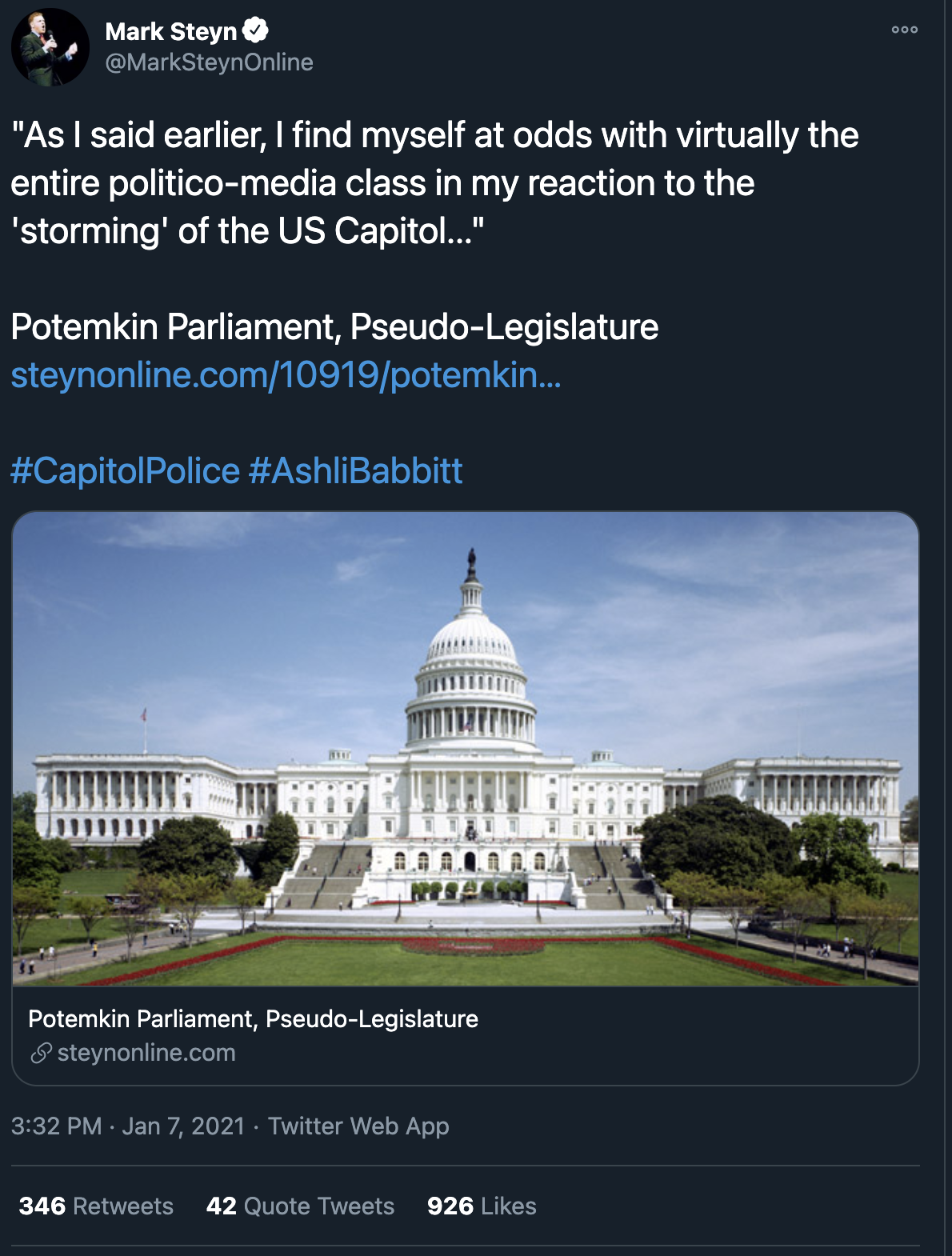Mark Steyn
Credentials
Mark Steyn attended the King Edward’s School in Birmingham, U.K., leaving in 1978, at the age of 18. Steyn does not appear to have a college education or any background in climate science.1“Mark Steyn,” Wikipedia. Archive.is URL: http://archive.is/i6wyz 2“Top American Conservative Mark Steyn Didn’t Go to College,” Edbasic, July 9, 2012. Archived September 2, 2014. Archive.is URL: https://archive.is/vVbLf
Background
Mark Steyn is the author and columnist of SteynOnline.com, where he writes “Steynposts”—commentary on current events—Monday through Friday, columns on politics and war, arts and culture, and on free-speech issues in the “Defend Free Speech! section” of his website.3“Defend Free Speech!” SteynOnline.com. Archived September 2, 2014. Archive.is URL: https://archive.is/bWnhl
Steyn regularly appears on television including The Rush Limbaugh Program and The Sean Hannity Show, in addition to a weekly appearance on The Hugh Hewitt Radio Show. Mark Steyn claims he “is an international bestselling author […] and a leading Canadian human rights activist.” According to his website, Steyn’s writing “has been published in almost every major newspaper around the English-speaking world, including Britain’s Daily Telegraph, Canada’s National Post, The Australian, The Irish Times, The Jerusalem Post, The Wall Street Journal, and many more.”4“Mark’s bio,” SteynOnline.com. Archive.is URL: https://archive.is/oK2t1
He briefly ran The Mark Steyn Show, a show that was only aired for two months before being cancelled by CRTV. The Daily Beast reported that Steyn subsequently sued the conservative media startup for cancelling his show.5Lachlan Market. “Inside the Collapse of the Mark Steyn Show,” The Daily Beast, March 13, 2017. Archived March 14, 2017 . Archive.is URL: https://archive.is/9b6qn
A 2004 profile of Steyn in the Boston Phoenix described him as “the most toxic right-wing pundit you’ve never heard of” and “a pungent columnist, essayist, and critic who’s not well known in the United States, but whose political screeds are published in English-speaking countries around the world. A native of Canada who divides his time among New Hampshire, Quebec, and London, Steyn is a self-described right-wing warmonger.”6Dan Kennedy. “Steyn’s way: Write, twist, smear, and sneer. Repeat!” Boston Phoenix, June 18, 2004. Archived March 23, 2016. Archive.is URL: https://archive.is/WBbbi
The Phoenix compared him to Rush Limbaugh and Ann Coulter, writing that Steyn possesses “a shrill, mocking tone of moral certainty that consigns those who disagree with him to the status of appeasers or even terrorists; and a willingness to distort, misrepresent, and omit facts in order to advance his argument.”7Dan Kennedy. “Steyn’s way: Write, twist, smear, and sneer. Repeat!” Boston Phoenix, June 18, 2004. Archived March 23, 2016. Archive.is URL: https://archive.is/WBbbi
Stance on Climate Change
August, 2014
“Now I don’t consider myself a big credentialed expert or anything. I simply looked at a graph Michael E Mann hadn’t been anywhere near and drew the obvious conclusion. Gave it two minutes’ thought, if that. The reason it’s taking climate science so much longer to draw that obvious conclusion is because ideology and the ideological enforcers like Mann got in the way.”8Mark Steyn. “Settled Science Catches Up with Steyn,” SteynOnline.com, August 27, 2014. Archive.is URL: https://archive.is/d1HiJ
July, 2009
“For the last century, we’ve had ever-so-slight warming trends and ever-so-slight cooling trends every 30 years or so, and I don’t think either are anything worth collapsing the global economy over.”9Mark Steyn. “Climate Change You Can Believe In,” National Review Online, July 25, 2009. Archived September 3, 2014. Archive.is URL: https://archive.is/cY2h2
Comments Surrounding 2021 Capitol Insurrection
Mark Steyn was among dozens of the individuals and organizations profiled in DeSmog’s Disinformation Database who posted online or gave interviews about the events surrounding the Jan. 6, 2021 Capitol insurrection. Some posted claims of election fraud, similar to those that drove the Stop the Steal rally on Jan. 6. Some circulated dubious information about the insurrection itself. DeSmog has preserved a selection of notable posts related to the events of Jan. 6, 2021, including some that were later deleted or removed.
Steyn appeared on the Fox News show Tucker Carlson Tonight on Jan. 6, 2021. He then recounted on his website:10Mark Steyn. “This Is Not Who We Are…” Steyn Online, January 7, 2021. Archived January 28, 2021. Archive URL: https://archive.vn/nvH6z
“On Wednesday I joined Tucker Carlson to discuss the so-called storming of the Capitol. …
The media may be sentimental about the Capitol, but in my unscientific survey of my North Country neighbors the people aren’t. Congress has an approval rating that falls somewhere between Isis and child pornographers. … The political class (represented by a Speaker who flies home to San Francisco on her own government plane) has been largely insulated from the pathologies they have loosed upon the land. For a few hours yesterday they weren’t. … During the early evening I found myself wondering why the pundits were so insistent on standing on the Capitol’s dignity. The obvious reason is that, for the most lavishly protected legislature in the world (okay, make that ‘legislature’), it was a total security fiasco – culminating in the murder of an unarmed woman by a (to put it mildly) totally incompetent copper firing into a crowd (which an American couldn’t do in, say, Kandahar). The rubbish about the ‘desecration’ of the ‘sacred’ ‘majesty’, etc, etc, peddled by Democrats and Republicans alike is designed to evade the vile reality of that grotesque act. …”
You can see the full hour of Tucker Carlson Tonight here.
He also posted the following quote, drawn from one of his own blogs, on Twitter on Jan. 7, 2021:


Key Quotes
November 23, 2018
Appearing on Fox News as a substitute host for Tucker Carlson on Tucker Carlson Tonight, Steyn was discussing the murder of Washington Post journalist Jamal Khashoggi with Nigel Farage when he said:
“And we should also be clear, too, Khashoggi is being presented as a hero of journalism. He’s probably going to be Time magazine’s Man of the Year just because he is a dead so-called journalist. But in fact he was kind of a deep state Saudi spook who just happened to fall out with the royal family. In a sense, it’s different sets of bad guys we’re arguing about when we’re talking about Saudi Arabia.”11Joe DePaolo. “Fox News Host: ‘Dead So-Called Journalist’ Khashoggi Really ‘Deep State Saudi Spook’,” Medaite, November 23, 2018. Archived November 24, 2018. Archive.is URL: archive.fo/v3RU8. Archived .mp4 on file at DeSmog.
January 18, 2018
On an episode of Tucker Carlson Tonight, Steyn criticised Nancy Pelosi and CNN’s Chris Cuomo for being more critical of white supremacists than undocumented immigrants:12Judd Legum. “The unrepentant racism of Tucker Carlson Tonight,” ThinkProgress, January 18, 2018.Archive.is URL: https://archive.is/On04n
“The white supremacists are American citizens. The illegal immigrants are people who shouldn’t be here,” Steyn said.
“[…] And this preference that Nancy Pelosi and Chris Cuomo and increasing people have for actually importing a class of citizen that they prefer to the ones they are stuck with is actually very revealing.”13Judd Legum. “The unrepentant racism of Tucker Carlson Tonight,” ThinkProgress, January 18, 2018.Archive.is URL: https://archive.is/On04n
April 2016
“Essentially we have two competing views of primitivism fighting for supremacy in our world. Both of them hate the Western developed world. The environmental crowd think it’s a great evil. So do the Sharia crowd. And once every so often these conflicting models of primitivism interact.
Earth hour. You know Earth hour? This ridiculous thing every year where they turn off the lights for an hour on a Saturday evening and you pretend you’re doing something to save the planet by sitting in the dark for an hour. In Sweden, a Swedish town a couple of weeks ago, they had to cancel earth hour because they’ve taken in so many so-called ‘refugees’ that it’s unsafe to switch the lights off for an hour. Because the hot Scandivanian blonds are going to be feeling a lot of unwanted attention as they’re wandering around an entirely darkened Swedish town for 60 minutes.
And that’s fascinating to me. That’s the the two different models of primitivism: Two groups that most hate the modern Western world and want to destroy it, and have competing models of primitivism. And the soft, delusional utopian primitivism of Western environmentalists when it came up against the hard, serious face of hardcore Islamic primitivism—Earth Hour in Sweden—the hardcore guys, their primitivism model won out. Because they mean it. And these soft, sappy, deluded, middle aged Western students don’t.”14“Mark Steyn’s Stand Against Climate Alarmism: In-Depth with the Climate Crybully Conniption-Inducer” (YouTube Video), uploaded by user The New Criterion, April 25, 2016. Archived .mp4 on file at Desmog.
November 2015
Mocking Bernie Sanders, on the November 16 edition of Fox Business’ Varney & Co. (video below):15“On Fox Business, Mark Steyn Invokes Image Of Terrorists ‘Sawing Bernie Sanders’ Head Off’ To Mock Him For Accurately Linking Climate Change To Terrorism,” Media Matters, November 16, 2015.
“[ISIS leader] al-Baghdadi will be sawing Bernie Sanders’ head off, and he’ll be saying as his neck is being sliced, ‘If only we’d had an emissions trading scheme.'”
April 2015
“There are all kinds of distinguished experts, including nobel prize winners all over the world who think that climate alarmism is a complete crock.”16“Lawton Online: Special guest Mark Steyn & more,” (YouTube Video) uploaded by user Rebel Media, April 16, 2015. Archived .mp4 on file at Desmog.
July 2014
“I want to get to court as soon as possible, and put Michael E Mann, PhD (Doctor of Phraudology) on the stand under oath. I haven’t wasted two years on this guy to be denied my moment in court. That’s one reason I’ve countersued Mann. He thinks the DC Superior Court is competent to litigate his fraudulent ‘hockey stick’. Fine, let’s get it to a jury – before the sclerotic DC ‘justice’ system’s procedural delays go on as long as the global-warming ‘pause’.”17Mark Steyn. “I’m Gonna Quash That Mann Right Out Of My Hair,” SteynOnline.Com. June 7, 2014. Archive.is URL: https://archive.is/rS1v6
December 2013
“Antarctic ice is now at a 35-year high. But scientists are “baffled” by the planet’s stubborn refusal to submit to their climate models … Global warming will kill us. Global cooling will kill us. And if it’s 54 and partly cloudy, you should probably flee for your life right now. Maybe scientists might usefully consider moving to being less hung up on “consensus” – a most unscientific and, in this context, profoundly corrupting concept.”18Mark Steyn. “Ice Everywhere, But No Hockey Sticks,” National Review Online, December 2, 2013. Archive.is URL: https://archive.is/DE1H5
July 2012
“Michael Mann was the man behind the fraudulent climate-change “hockey-stick” graph, the very ringmaster of the tree-ring circus.”19Mark Steyn. “Football and Hockey,” National Review Online, July 15, 2012. Archive.is URL: https://archive.is/2fG6K
Key Deeds
January 18, 2018
ThinkProgress reported that Steyn presented “racist commentary” about Hispanic Americans on an epsiode of Fox News’ Tucker Carlson Tonight. According to Steyn, the “majority of grade school students in Arizona are Hispanic,” and suggests this means that “Arizona’s future is as an Hispanic society.” “That means, in effect, the border has moved north,” Steyn said.20Judd Legum. “The unrepentant racism of Tucker Carlson Tonight,” ThinkProgress, January 18, 2018.Archive.is URL: https://archive.is/On04n
Earlier in the program, Steyn criticized Nancy Pelosi and CNN’s Chris Cuomo for being more critical of white supremacists than undocumented immigrants who came to the U.S. as children.
“The white supremacists are American citizens. The illegal immigrants are people who shouldn’t be here,” Steyn said.21Judd Legum. “The unrepentant racism of Tucker Carlson Tonight,” ThinkProgress, January 18, 2018.Archive.is URL: https://archive.is/On04n
March, 2017
Mark Steyn sued CRTV after the company cancelled The Mark Steyn Show, which had aired for two months. Steyn said that his “employees will suffer irreparable harm because they will lose their health insurance coverage as a result of [CRTV’s] actions.22Lachlan Market. “Inside the Collapse of the Mark Steyn Show,” The Daily Beast, March 13, 2017. Archived March 14, 2017 . Archive.is URL: https://archive.is/9b6qn
Steyn wrote on his website that he was protecting his employees interests in the suit, as “I didn’t feel the cameramen and production assistants and musicians and audio engineers should have to suffer because I was stupid enough to get into bed with CRTV.”23“Announcing… The Mark Steyn Show Bag! (All bag, no show),” Steyn Online, March 4, 2017. Archived March 14, 2017. Archive.is URL: https://archive.is/fyOyT
The Daily Beast reported that not all employees agreed with Steyn’s intentions. Mike Young, supervisor for the show, said “It’s bullshit, frankly. They all hate him.”24Lachlan Market. “Inside the Collapse of the Mark Steyn Show,” The Daily Beast, March 13, 2017. Archived March 14, 2017 . Archive.is URL: https://archive.is/9b6qn
Styn’s CRTV contract demanded five episodes per week, amounting to about 45 minutes each when including time for commercial breaks. However, CRTV claimed that Styn only produced 11 episodes longer than 40 minutes, and had sent Steyn a breach of contract on February 8 requiring him to produce eight full-length episodes. When he only turned in four, the company informed Steyn the show had been cancelled on February 20. Steyn filed the lawsuit on February 22.25Lachlan Market. “Inside the Collapse of the Mark Steyn Show,” The Daily Beast, March 13, 2017. Archived March 14, 2017 . Archive.is URL: https://archive.is/9b6qn
The show’s crew members told The Daily Beast, in sworn declarations, that they thought Mark Steyn’s “lack of preparation and refusal to cooperate” made it impossible to meet the production requirements. According to another sworn declaration, “Mark Steyn was incredibly disorganized, often did not show up on scheduled production days, and snuck out of the studio so that nobody would know his whereabouts. Because of this conduct, it would take a week to shoot an episode instead of the designated day.”26Lachlan Market. “Inside the Collapse of the Mark Steyn Show,” The Daily Beast, March 13, 2017. Archived March 14, 2017 . Archive.is URL: https://archive.is/9b6qn
March 29, 2016
Mark Steyn was a featured speaker at a conference titled “The Climate Surprise: Why CO2 Is Good for the Earth” hosted by the CO2 Coalition and The New Criterion in New York City.27“The Climate Surprise: Why CO2 is Good for the Earth,” CO2 Coalition, April 25, 2016. Archived May 7, 2016. Archive.is URL: https://archive.is/BWkqz
According to the event description, “Members of the CO2 Coalition and many other experts argue that carbon dioxide enrichment of the atmosphere provides manifold benefits for humanity. And observed surface warmings are much smaller than predicted by climate models. Economic models that fail to include the benefits of CO2 and the serious exaggerations of climate models and are being used to advocate “cures” that are much worse than the non-existent disease.” Videos of Steyn’s talks below.28“The Climate Surprise: Why CO2 is Good for the Earth,” CO2 Coalition, April 25, 2016. Archived May 7, 2016. Archive.is URL: https://archive.is/BWkqz
All of Mark Steyn’s videos, as well as video coverage of other speakers are available at The New Criterion‘s YouTube page. Featured speakers listed at the event included the following:
February, 2016
The Institute for Public Affairs (IPA) sponsored Mark Steyn’s speaking tour across Australia, Desmog reported. IPA promoted Steyn as “the world’s greatest conservative commentator and writer.”29Graham Readfearn. “Climate Science Denier Mark Steyn Tours Australia… And Other Reptilian Illuminati David Icke Weirdness,” Desmog, February 16, 2016. 30“Mark Steyn Australian Tour,” Institute of Public Affairs. Archived September 27, 2016. Archive. is URL: https://archive.is/y4AIz
December 8, 2015
Set to coincide with the Paris COP21 (Conference of the Parties), Mark Steyn testified at a hearing of the Subcommittee on Space, Science, and Competitiveness convened by U.S. Sen. Ted Cruz (R-Texas) titled “Data or Dogma? Promoting Open Inquiry in the Debate over the Magnitude of Human Impact on Earth’s Climate.”31“Data or Dogma? Promoting Open Inquiry in the Debate over the Magnitude of Human Impact on Earth’s Climate,” U.S. Senate Committee on Commerce, Science, & Transportation. Archived December 4, 2015. Archive.is URL: https://archive.is/9SbTE
According to the event description, the hearing focused on “the ongoing debate over climate science, the impact of federal funding on the objectivity of climate research, and the ways in which political pressure can suppress opposing viewpoints in the field of climate science.”32“Data or Dogma? Promoting Open Inquiry in the Debate over the Magnitude of Human Impact on Earth’s Climate,” U.S. Senate Committee on Commerce, Science, & Transportation. Archived December 4, 2015. Archive.is URL: https://archive.is/9SbTE
Ars Technicha summarized Steyn’s testimony as follows:33Scott K. Johnson. “Senate Science Committee hearing challenges ‘dogma’ of climate science,” Ars Technica, December 9, 2015. Archived December 10, 2015. Archive.is URL: https://archive.is/HDE02
“Mark Steyn’s testimony focused on his accusations that climate science is fraudulent and oppresses contrarians. Steyn’s claim to climate fame is that he’s being sued for defamation by Penn State climate scientist Michael Mann, whom Steyn has repeatedly accused of fraud.”
Steyn’s full testimony (PDF) us available on the Senate Committee’s website.34“Statement to the Subcommittee on Space, Science and Competitiveness of the United States Senate” (PDF), U.S. Senate Committee on Commerce, Science, & Transportation, December 8, 2015. Archived .pdf on file at DeSmog.
Other witnesses at the event included:
- Dr. John Christy
- Dr. Judith Curry
- Dr. William Happer
- Dr. David Titley (Rear Admiral, USN (ret.)
September 1, 2015
Steyn is the editor and author of a book attacking climate scientist Michael Mann titled A Disgrace to the Profession. Daily KOS noted that, in the promotional materials for his book, Steyn took a number of quotes out of context. One scientist Steyn quoted had previously co-authored a paper supported Mann’s findings, a second had worked on a paper that confirmed Mann’s findings, and another was contacted and said that Steyn’s attacks on Mann “have no justification.” One quote is from a physicist who does not work in the field of climate science.35“Steyn’s Peer-Review of Mann Backfires,” DailyKOS, June 23, 2015. Archive.is URL: https://archive.is/kftIL
June 11–12, 2015
Mark Steyn was a speaker at the Heartland Institute’s Tenth International Conference on Climate Change (ICCC10) in Washington, D.C.36“Speakers,” Heartland Institute. Archived June 30, 2015. Archive.is URL: https://archive.is/lpiqu
View Mark Steyn’s Breakfast Keynote presentation at the Heartland Institute’s ICCC10, below:37“Breakfast Keynote with Mark Steyn,” Heartland Institute, June 12, 2015. Archived July 14, 2015. Archived .mp4 on file at Desmog.
April 2015
Mark Steyn spoke about Climate Change: The Facts on the inaugural “Lawton Online” podcast for TheRebel.Media (see below, starting at time 43:15). According to Steyn, “We have now been 18 years without global warming.” He says is is proud to be among some of “the world’s most eminent scientists” as well as “the fellows who are there for a cheap knockabout like me” who appear in the book.38“Lawton Online: Special guest Mark Steyn & more,” (YouTube Video) uploaded by user Rebel Media, April 16, 2015. Archived .mp4 on file at Desmog.
Steyn describes Donna Laframboise as a “old colleague of mine from the National Post days.” Steyn also makes an unoffical challenge to David Suzuki to debate him on live television, saying that while he is not a climate change expert, he is “far more of an expert than [Suzuki] is.”39“Lawton Online: Special guest Mark Steyn & more,” (YouTube Video) uploaded by user Rebel Media, April 16, 2015. Archived .mp4 on file at Desmog.
December 2014
Mark Steyn is a contributor to the book Climate Change: The Facts published by the Institute of Public Affairs and featuring “22 essays on the science, politics and economics of the climate change debate.” The Institute of Public Affairs, while not revealing most of its funders, is known to have received funding from mining magnate Gina Rinehart and at least one major tobacco company.40“Institute of Public Affairs,” SourceWatch. Accessed May 27, 2015. Archive.is URL: https://archive.is/RtEoe
The book includes essays and articles from a range of climate change skeptics, with contributors including the following:
- Alan Moran
- Andrew Bolt
- Anthony Watts
- Bernard Lewin
- Christopher Essex
- Donna Laframboise
- Garth W. Paltridge
- Ian Plimer
- J. Scott Armstrong
- James Delingpole
- Jennifer Marohasy
- Joanne Nova
- John Abbot
- Kesten Green
- Mark Steyn
- Nigel Lawson
- Patrick J. Michaels
- Richard S. Lindzen
- Robert M. Carter
- Ross McKitrick
- Rupert Darwall
- Stewart Franks
- Willie Soon
Editor Alan Moran summarized Steyn’s contribution as follows:
Mark Steyn’s essay ‘Ship of Fools’ demonstrates how environmental activist, Professor Chris Turney inadvertently parodied Douglas Mawson’s Antarctic expedition. Turney had expected to see a path to the Pole cleared for his ship by global warming. After all, Al Gore had predicted an ice free Arctic by now. Instead, Turney’s Guardian backed expedition had to be rescued from expanding ice. A genuine scientist, as Turney claims to be, should have realised that Antarctic ice is expanding not increasing.41Alan Moran. “Climate Change: the facts 2014,” Catallaxy Files (blog), December 16, 2014. Archive.is URL: https://archive.is/tCUVU
As reported by DeSmog, just as Steyn did in his article in The Spectator, Moran failed to point out that Turney’s expedition did know about recent sea ice trends in Antarctica because they explicitly identified this as something to study before they set off.42Graham Readfearn. “Australian Tax Breaks Help Fund Climate Science Denier Mark Steyn’s Libel Defense in the US,” DeSmog, May 14, 2015. 43Graham Readfearn. “What’s going on with global warming and Antarctica’s growing sea ice?” The Guardian, March 11, 2014. Archive.is URL: https://archive.is/icllv
November 25, 2014
Mark Steyn was called to the D.C. Court of Appeals over the defamation suit originally filed by Michael Mann in 2012 in response to Steyn’s July 2012 piece in the National Review titled “Football and Hockey.” The case has gone back and forth since 2012, with Steyn suggesting that Mann has extended the proceedings to make it more costly for the participants. Steyn had said he would represent himself, however later chose representation from Yale-Educated Dan Kornstein.44Betsy Rothstein.”Mark Steyn To D.C. Court For Defamation Hearing (You Won’t Want To Miss This),” The Daily Caller, November 24, 2014. Archive.is URL: https://archive.is/EHGIM 45Jonathan H. Adler. “Mann v. Steyn — Steyn goes his own way,” The Washington Post, June 9, 2014.
In his amicus brief (PDF), Steyn states that “The audacity of the falsehoods in Mann’s court pleadings is breathtaking” and claims that Mann has “manipulated” the anti-SLAPP process in order to slow proceedings for the purpose of “protracted and inevitably expensive litigation.”46“BRIEF OF AMICUS CURIAE MARK STEYN IN SUPPORT OF NEITHER PARTY” (PDF), Retrieved from Steynonline.com. Archived .pdf on file at Desmog.
The blog Popehat reported in detail on the legal proceedings, going back to the start of the suit in 2012.47“D.C. Court of Appeals Agrees to Hear Merits of Anti-SLAPP Appeal In Michael Mann’s Defamation Case,” Popehat, May 2, 2014. Archived September 27, 2016. Archive.is URL: https://archive.is/HHbXe
July 15, 2012
Mark Steyn publishes a piece in the National Review Online titled, “Football and Hockey.”48Mark Steyn. “Football and Hockey,” National Review Online, July 15, 2012. Archive.is URL: https://archive.is/2fG6K
The piece resulted in Dr. Michael Mann, of Penn State University, suing Mark Steyn, National Review Online, the Competitive Enterprise Institute (CEI), and CEI analyst Randy Simberg for “defamatory articles accusing him [Mann] of academic fraud and comparing him to a convicted child molester, former Penn State assistant football coach Jerry Sandusky,” on July 23, 2012.49“Could A Climate Scientist’s Defamation Suit Shut Down The Nation’s Leading Conservative Magazine?,” Climate Progress, February 3, 2014. Archive.is URL: https://archive.is/wXQLW 50Mark Steyn. “Mann-made climate change turns up the heat on Steyn,” SteynOnline.com, July 23, 2012. Archive.is URL: https://archive.is/VywaB
Steyn’s article “claimed Mann had ‘molested and tortured data,’ and described Mann’s famous ‘hockey stick’ graph as ‘fraudulent’.”51“Could A Climate Scientist’s Defamation Suit Shut Down The Nation’s Leading Conservative Magazine?,” Climate Progress, February 3, 2014. Archive.is URL: https://archive.is/wXQLW
Affiliations
- SteynOnline.com 52“Mark’s bio,” SteynOnline.com. Archive.is URL: https://archive.is/oK2t1
Publications
According to a search of Google Scholar, Mark Steyn has not published any research in peer-reviewed journals. The search does list that he has published numerous books including America alone: The end of the world as we know it, After America: Get Ready for Armageddon, and Broadway Babies Say Goodnight: Musicals Then and Now.53“Mark Steyn,” Google Scholar search.
Social Media
- @MarkSteynOnline on Twitter
Other Resources
Resources
- 1“Mark Steyn,” Wikipedia. Archive.is URL: http://archive.is/i6wyz
- 2“Top American Conservative Mark Steyn Didn’t Go to College,” Edbasic, July 9, 2012. Archived September 2, 2014. Archive.is URL: https://archive.is/vVbLf
- 3“Defend Free Speech!” SteynOnline.com. Archived September 2, 2014. Archive.is URL: https://archive.is/bWnhl
- 4“Mark’s bio,” SteynOnline.com. Archive.is URL: https://archive.is/oK2t1
- 5Lachlan Market. “Inside the Collapse of the Mark Steyn Show,” The Daily Beast, March 13, 2017. Archived March 14, 2017 . Archive.is URL: https://archive.is/9b6qn
- 6Dan Kennedy. “Steyn’s way: Write, twist, smear, and sneer. Repeat!” Boston Phoenix, June 18, 2004. Archived March 23, 2016. Archive.is URL: https://archive.is/WBbbi
- 7Dan Kennedy. “Steyn’s way: Write, twist, smear, and sneer. Repeat!” Boston Phoenix, June 18, 2004. Archived March 23, 2016. Archive.is URL: https://archive.is/WBbbi
- 8Mark Steyn. “Settled Science Catches Up with Steyn,” SteynOnline.com, August 27, 2014. Archive.is URL: https://archive.is/d1HiJ
- 9Mark Steyn. “Climate Change You Can Believe In,” National Review Online, July 25, 2009. Archived September 3, 2014. Archive.is URL: https://archive.is/cY2h2
- 10Mark Steyn. “This Is Not Who We Are…” Steyn Online, January 7, 2021. Archived January 28, 2021. Archive URL: https://archive.vn/nvH6z
- 11Joe DePaolo. “Fox News Host: ‘Dead So-Called Journalist’ Khashoggi Really ‘Deep State Saudi Spook’,” Medaite, November 23, 2018. Archived November 24, 2018. Archive.is URL: archive.fo/v3RU8. Archived .mp4 on file at DeSmog.
- 12Judd Legum. “The unrepentant racism of Tucker Carlson Tonight,” ThinkProgress, January 18, 2018.Archive.is URL: https://archive.is/On04n
- 13Judd Legum. “The unrepentant racism of Tucker Carlson Tonight,” ThinkProgress, January 18, 2018.Archive.is URL: https://archive.is/On04n
- 14“Mark Steyn’s Stand Against Climate Alarmism: In-Depth with the Climate Crybully Conniption-Inducer” (YouTube Video), uploaded by user The New Criterion, April 25, 2016. Archived .mp4 on file at Desmog.
- 15
- 16“Lawton Online: Special guest Mark Steyn & more,” (YouTube Video) uploaded by user Rebel Media, April 16, 2015. Archived .mp4 on file at Desmog.
- 17Mark Steyn. “I’m Gonna Quash That Mann Right Out Of My Hair,” SteynOnline.Com. June 7, 2014. Archive.is URL: https://archive.is/rS1v6
- 18Mark Steyn. “Ice Everywhere, But No Hockey Sticks,” National Review Online, December 2, 2013. Archive.is URL: https://archive.is/DE1H5
- 19Mark Steyn. “Football and Hockey,” National Review Online, July 15, 2012. Archive.is URL: https://archive.is/2fG6K
- 20Judd Legum. “The unrepentant racism of Tucker Carlson Tonight,” ThinkProgress, January 18, 2018.Archive.is URL: https://archive.is/On04n
- 21Judd Legum. “The unrepentant racism of Tucker Carlson Tonight,” ThinkProgress, January 18, 2018.Archive.is URL: https://archive.is/On04n
- 22Lachlan Market. “Inside the Collapse of the Mark Steyn Show,” The Daily Beast, March 13, 2017. Archived March 14, 2017 . Archive.is URL: https://archive.is/9b6qn
- 23“Announcing… The Mark Steyn Show Bag! (All bag, no show),” Steyn Online, March 4, 2017. Archived March 14, 2017. Archive.is URL: https://archive.is/fyOyT
- 24Lachlan Market. “Inside the Collapse of the Mark Steyn Show,” The Daily Beast, March 13, 2017. Archived March 14, 2017 . Archive.is URL: https://archive.is/9b6qn
- 25Lachlan Market. “Inside the Collapse of the Mark Steyn Show,” The Daily Beast, March 13, 2017. Archived March 14, 2017 . Archive.is URL: https://archive.is/9b6qn
- 26Lachlan Market. “Inside the Collapse of the Mark Steyn Show,” The Daily Beast, March 13, 2017. Archived March 14, 2017 . Archive.is URL: https://archive.is/9b6qn
- 27“The Climate Surprise: Why CO2 is Good for the Earth,” CO2 Coalition, April 25, 2016. Archived May 7, 2016. Archive.is URL: https://archive.is/BWkqz
- 28“The Climate Surprise: Why CO2 is Good for the Earth,” CO2 Coalition, April 25, 2016. Archived May 7, 2016. Archive.is URL: https://archive.is/BWkqz
- 29Graham Readfearn. “Climate Science Denier Mark Steyn Tours Australia… And Other Reptilian Illuminati David Icke Weirdness,” Desmog, February 16, 2016.
- 30“Mark Steyn Australian Tour,” Institute of Public Affairs. Archived September 27, 2016. Archive. is URL: https://archive.is/y4AIz
- 31“Data or Dogma? Promoting Open Inquiry in the Debate over the Magnitude of Human Impact on Earth’s Climate,” U.S. Senate Committee on Commerce, Science, & Transportation. Archived December 4, 2015. Archive.is URL: https://archive.is/9SbTE
- 32“Data or Dogma? Promoting Open Inquiry in the Debate over the Magnitude of Human Impact on Earth’s Climate,” U.S. Senate Committee on Commerce, Science, & Transportation. Archived December 4, 2015. Archive.is URL: https://archive.is/9SbTE
- 33Scott K. Johnson. “Senate Science Committee hearing challenges ‘dogma’ of climate science,” Ars Technica, December 9, 2015. Archived December 10, 2015. Archive.is URL: https://archive.is/HDE02
- 34“Statement to the Subcommittee on Space, Science and Competitiveness of the United States Senate” (PDF), U.S. Senate Committee on Commerce, Science, & Transportation, December 8, 2015. Archived .pdf on file at DeSmog.
- 35“Steyn’s Peer-Review of Mann Backfires,” DailyKOS, June 23, 2015. Archive.is URL: https://archive.is/kftIL
- 36“Speakers,” Heartland Institute. Archived June 30, 2015. Archive.is URL: https://archive.is/lpiqu
- 37“Breakfast Keynote with Mark Steyn,” Heartland Institute, June 12, 2015. Archived July 14, 2015. Archived .mp4 on file at Desmog.
- 38“Lawton Online: Special guest Mark Steyn & more,” (YouTube Video) uploaded by user Rebel Media, April 16, 2015. Archived .mp4 on file at Desmog.
- 39“Lawton Online: Special guest Mark Steyn & more,” (YouTube Video) uploaded by user Rebel Media, April 16, 2015. Archived .mp4 on file at Desmog.
- 40“Institute of Public Affairs,” SourceWatch. Accessed May 27, 2015. Archive.is URL: https://archive.is/RtEoe
- 41Alan Moran. “Climate Change: the facts 2014,” Catallaxy Files (blog), December 16, 2014. Archive.is URL: https://archive.is/tCUVU
- 42Graham Readfearn. “Australian Tax Breaks Help Fund Climate Science Denier Mark Steyn’s Libel Defense in the US,” DeSmog, May 14, 2015.
- 43Graham Readfearn. “What’s going on with global warming and Antarctica’s growing sea ice?” The Guardian, March 11, 2014. Archive.is URL: https://archive.is/icllv
- 44Betsy Rothstein.”Mark Steyn To D.C. Court For Defamation Hearing (You Won’t Want To Miss This),” The Daily Caller, November 24, 2014. Archive.is URL: https://archive.is/EHGIM
- 45Jonathan H. Adler. “Mann v. Steyn — Steyn goes his own way,” The Washington Post, June 9, 2014.
- 46“BRIEF OF AMICUS CURIAE MARK STEYN IN SUPPORT OF NEITHER PARTY” (PDF), Retrieved from Steynonline.com. Archived .pdf on file at Desmog.
- 47“D.C. Court of Appeals Agrees to Hear Merits of Anti-SLAPP Appeal In Michael Mann’s Defamation Case,” Popehat, May 2, 2014. Archived September 27, 2016. Archive.is URL: https://archive.is/HHbXe
- 48Mark Steyn. “Football and Hockey,” National Review Online, July 15, 2012. Archive.is URL: https://archive.is/2fG6K
- 49“Could A Climate Scientist’s Defamation Suit Shut Down The Nation’s Leading Conservative Magazine?,” Climate Progress, February 3, 2014. Archive.is URL: https://archive.is/wXQLW
- 50Mark Steyn. “Mann-made climate change turns up the heat on Steyn,” SteynOnline.com, July 23, 2012. Archive.is URL: https://archive.is/VywaB
- 51“Could A Climate Scientist’s Defamation Suit Shut Down The Nation’s Leading Conservative Magazine?,” Climate Progress, February 3, 2014. Archive.is URL: https://archive.is/wXQLW
- 52“Mark’s bio,” SteynOnline.com. Archive.is URL: https://archive.is/oK2t1
- 53“Mark Steyn,” Google Scholar search.






